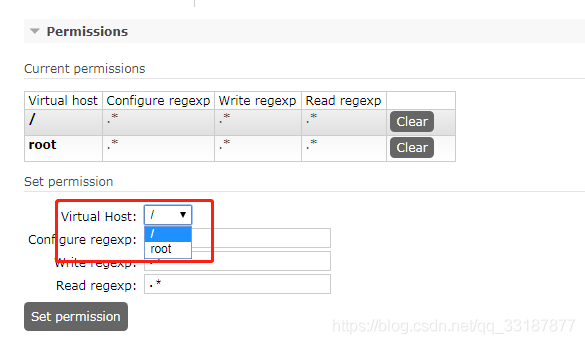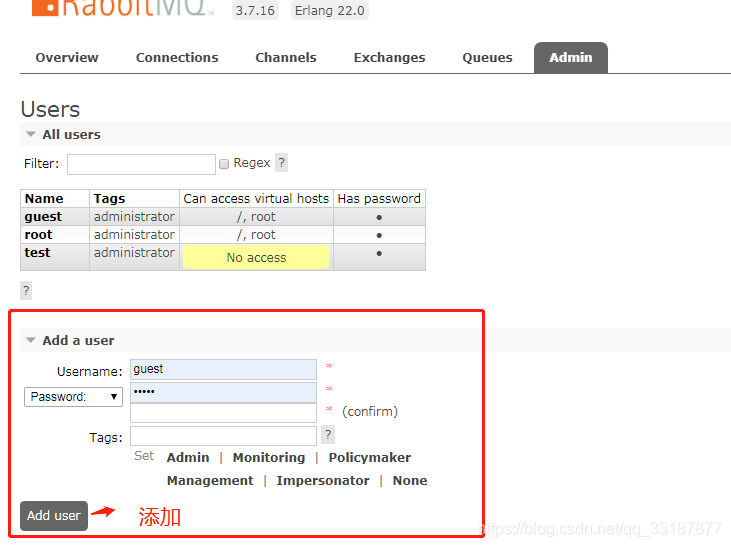RabbitMQ一些积累记录
一、JAVA直接调用RabbitMQ的API获取队列、用户、虚拟机等信息。
@scheduled(cron = "* 0/2 * * * ?") public void startMonitor() throws CLientProtocolException, IOException { String rabbitmqMsg = getRabbitmqMsg("/api/queues", username.password, host, port); List<JSONObject> parseArray = JSONArray.parseArray(rabbitmqMsg, JSONObject.class); if (parseArray == null || parseArray.size() == 0) { return; } for (int i = 0; i < parseArray.size(); i++) { //获取队列里的消息数量 BigDecimal messages = parseArray.get(i).getBigDecimal("messages"); //获取虚拟机名 String vhost = parseArray.get(i).getString("vhost"); //获取队列名 String name = parseArray.get(i).getString("name"); System.out.println(vhost + name + "消息数量" + messages); } } /** * @param tailUrl 尾缀 * @param userName 较大权限的用户名(可查看队列信息) * @param password 较大权限的用户的密码 * @param hostIp 访问的主机IP * @param port 访问的rabbitmq端口(一定是web管理端口,默认15672,不是连接端口5672) * @return * @throws CLientProtocolException * @throws IOException */ public String getRabbitmqMsg(String tailUrl, String userName, String password, String hostIp, int port) throws CLientProtocolException, IOException { HostPost host = new HostPost(hostIp, port); HttpGet httGet = new HttpGet(tailUrl); //开始基于Bisc模式认证用户名密码 BasicCredentialsProvider credentialsProvider = new BasicCredentialsProvider(); credentialsProvider.setCredentials(new AuthScope(hostIp.port), new UsernamePasswordCredentials(userName, password)); DefaultHttpClient client = new DefaultHttpClient(); client.setCredentialsProvider(credentialsProvider); HttpResponse execute = client.execute(host, httGet); HttpEntity entity = execute.getEntity(); return EntityUtils.toString(entity); }
有关于RabbitMQ的API使用,可查看rabbitmq的web管理页ip:15672/api查看。更多信息也可查看json字符串后自行截取。
二、springboot连接rabbitmq发生socket closed异常
该情况有几种排查方案。
1.检查配置文件端口是否是5672,因为rabbitmq连接的不是web管理端,很多时候粗心出现这个错误。只有访问Web API时才设定15672.
2.不管是集群还是单机模式,一般都会配置下hosts文件的主机名。检查下host是否被篡改导致的。
3.在web管理页检查配置的用户是否有操作当前队列的权限。如未绑定虚拟机、交换机权限。
以下图片从网络寻找。


三、springboot使用rabbitmq配置集群
package com.chx.util; import com.rabbitmq.client.ConnectionFactory; import org.springframework.amqp.rabbit.connection.CachingConnectionFactory; import org.springframework.context.annotation.Bean; import org.springframework.context.annotation.Configuration; @Configuration public class RabbitmqConfig { private String hosts = "127.0.0.1:5672,127.0.0.2:5672"; @Bean public ConnectionFactory connectionFactory(){ CachingConnectionFactory connectionFactory = new CachingConnectionFactory(); connectionFactory.setAddresses(hosts); connectionFactory.setUsername(""); connectionFactory.setPassword(""); connectionFactory.setVirtualHost(""); } }